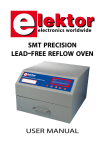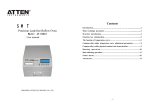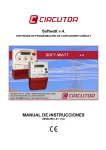Download AT-R1825 Manual
Transcript
一、功能 二 简 四 … 介 、主要 三、各部分名称及功能简介 ......... 技术 ...... ……… ……… ...... 按键 ……… ……… 参数… ..... 、功能 …… …… ..... ……… ...... ……… 说明… ………… ……… ...... …… ……… ........ ……… …… ...... ………… .. …. ..... ……… ...... …… . ...... . 4 温度 、 、常用 钎料的 合金 温度曲 线调 …. 整参数……… ……… .. …… 七 . . . .... ..... ..... .. ....... ..... ..... .... ..... SM T 设 备 回 密 无 铅 回 焊 炉 Model: AT-R1825 用 手册 ……… 数设置 参 焊 故 、 设备的 、 装和安 安 环境 … 装 …… ……… … … ………… ……… …… . ……… ………… . 5- ……… . …… 运 7 . …… 10 ………… . . . . . 8 表 -1 … 一 … … … … … … … … … … … … … … … … … … … 8 8 … 行 ……… 报警 障 ……… ……… …… ………… … … … … ....20 -2 … … … … … … … … … … … … … … … … … … 1 9 1 ………22 ……… 注意事项 、 ……… ……… ……… ………… ……… .3 2 Contents C 精 Precision Lead-free Reflow Oven 使 ……… . .9 运行 、 、 十一 十三 用与功能 作 . 附 ..... 九 十二 ……… 线的 曲 . 、 ..... ..... 录 2 .4 .. …. 五 六 八、常用合金钎料物理常数和特征 ...... 十 目 2 ……… ………… . ……… User manual Introduction……………………………………………………......................2 Main technique parameter…………………………………….......................3 Structure introduction………………………………………..........................5 Function key introduction………………………………………………..….6 The function of temperature curve……………………………………….....6 Common alloy solder temperature curve adjustment parameters…………...9 Common alloy solder physical constant and characteristics…………….....10 Running operation………………………………………………….................11 Back soldering operation………………………………………………….....19 Faults alarm……………………………………………………………....…20 Attentions………………………………………………..………………….22 Parameters of the fixed curves …………...……..………………………….22 深 圳 市安 泰信 电子 有 限公 司 SHENZHEN ATTEN ELECTRONICS CO., LTD. -1- Introduction Main technique parameter The “IR LEAD-LESS REFLOW OVEN” is equipment that used for electron production and maintain of SMT technique. The product adopts the far-infrared heating components and excellent sense temperature materials. Through the precise control of the microcomputer, make the temperature control curve match to the request of the SMT production technique completely. The “temperature control curve” of the equipment can be adjusted accurately, 1、 Working voltage: AC220V(AC110V order) 2、 Working frequency:50-60Hz 3、 Maximum output power: 600W 4、 Heating methods: infrared radiation and hot air mix heating 5、 Operating system: Chinese-English operating system so it can satisfy the request of many kinds of soldering paste which are different 6、 Working mode: automatic soldering mode, maintenance mode adjustable material parameters. It can shut down and alarm the faults automatically. Also it 7、 Temperature curve paragraph: preservation and cooling segment. has many functions, such as soldering, maintenance and drying. The structural performance and operation has been upgraded and improved. Using Chinese-English bilingual operating system and efficient and warm-up, heating, soldering, heat 8、 Range of temperature and time on warm-up: 70~150℃, 0~5Min 9、 Range of temperature and time on heating: warm-up temperature to 220℃, 0~5Min 10、 Range of temperature and time on soldering: heating temperature to 300℃, 0~30s convenient power switch. 11、 Range of temperature and time on heating preservation: soldering temperature -(0~50℃) 12、 Effective soldering area: 220×280mm 13、Size: 428×350×220mm -2- -3- Power jack, fuse, and power switch Structure introduction Main body Display Work salver Shape the structure of Operate button Salver pull Fig 1 Mechanical structure Work salver: placed PCB board and other drying goods Salver pull: pull the salver to placed things Power jack, fuse and power switch: supply power for main body and suddenness protect Display: display the setting parameter and working state View after -4- Operate button: operate the machine and setting parameter -5- of the board and the number of the components. 2. The purpose and role of the heating Function key introduction “RUN”Button “SET”Button “È”Button “Ç”Button “ON/OFF”Button Activated the liquid flux of tin pulp; under the role of the liquid flux remove the oxide of surface components inside the tin pulp; preparation for soldering. In this section the temperature of the lead alloy solder and precious metal alloy solder should be set (150℃~180℃). eg: Sn42%-Bi58% Indium tin alloy low temperature Lead Solder, Sn43%-Pb43%-Bi14% low-temperature lead solder and so on. Set the Mid-temperature lead solder alloy temperature between (180~220℃); Set the high temperature lead-free solder alloy temperature between (220~250℃). If you have solder and tin pulp information, the temperature of the heating can be installed in less than tin pulp melting point temperature of 10 ° C is the best around. Fig 2Operation Panel ON/OFF: press the key to turn on or turn off the machine. If the working state hasn’t quit or the temperature hasn’t declined to safety the system can’t force quit. “Ç” “È”: using to change the setting parameter. SET: running setting parameter and save the setting. RUN: running the machine, exit running state or exit setting state. The function of temperature curve In the SMT production process,adjust the temperature curve according to different alloy formula or tin solder paste, which make the better quality of product. Usually the reflow soldering has five temperature segments. The temperature and the time can be set to satisfy the request of different PCB board. In order to better explain the requirements of the various temperatures and the role we will describe every temperature segment in the follow. 1. The purpose and role of the warm-up 3. The purpose and role of the soldering The purpose is to complete the SMT soldering. As this stage is the highest temperature in the whole soldering process, the components is easy to damage. This process the solder physical and chemical changes of the largest are also to the improvement of soldering process. The solder dissolves very easily in the high temperature oxidation in air. If you have solder and tin pulp information, you can installed the temperature of the soldering higher than tin pulp melting point temperature of (30~50° C). We divided the solder into three: low temperature solder ( 150~180 ℃ ) ,mid-temperature solder ( 190-220℃ ) , high-temperature solder(230~260℃). Now commonly used lead-free solder materials for high-temperature solder, low-temperature solder is generally precious metals lead-free solder and the special requirements of low-temperature lead solder,General electronic products use rarely, it often use in specific requirements for electronic equipment. At present, many lead-free solder are also no substitute for lead solder as the mid-temperature leaded solder has excellent electrical properties, mechanical properties, impact resistance properties of hot and cold, the antioxidant properties, therefore, in a common electronic products also large-scale use. Heating the PCB board from room temperature to 120~150℃ which make the moisture fully volatile and eliminate the internal stress and some residue gas of the PCB board. It is a gentle transition of next temperature paragraph also, setting the time 1~5Min in this segment. You also can set the time by the size In this segment you can set the time according to the requirement in the following. After high temperature melting solder shown as liquid all the components of SMT floating on the surface of the liquid solder. In the surface tension effects of the flux and liquid, floating components will be move to the center of the solder pad have the role of reform automatically. Also in the -6- -7- humid of the solder flux the solder tin and surface metal of components formed alloy layer infiltrated into components structural organization, which form the ideal soldering structural. Setting the time about (10~30s), a large area and the larger components shade of PCB should be set much longer time. The small area or less parts PCB set shorter time generally. In order to ensure quality of back solder in this stage should shorten the time as much as possible to protecting components. 4. The purpose and role of the heat preservation Let high-temperature liquid solder solidified into solid-state soldering points. Solidification quality has a direct impact the crystal structure of the solder and mechanical properties. If the solidification to fast will lead the solder formation of crystalline rough, solder joint is not bright, mechanical properties decrease. Under high temperature and mechanical impact, soldering points easily crack lose mechanical and electrical connections role, lower product durability. We always use to stop heating methods and heat preservation for some time. In the temperature slow decline process the solder can solidification and crystal good. Generally set the temperature point lower than the solder point 10-20 ° C around. Use of natural cooling when the temperature dropped to the temperature point it will enter cooling paragraph. 5. The purpose and role of the cooling paragraph This cooling segment is simple, usually cooled to the temperature will not scalding the people. To speed up the process of operation, may also stop the process when the temperature fell to below 150℃. To avoid burns to use tools, hand belt or heat resistant grove take out the PCB board. 6. Note General temperature curve set from the low-temperature, after satisfy the soldering requirements as much as possible to reduce the soldering temperature. Also can through extend back soldering time to reduce the temperature, this will be conducive to the protection of low-temperature components, especially some connectors and plug. Some components can not satisfy temperature requirement, can be used to after soldering to solve. -8- Common alloy solder temperature curve adjustment parameters Solder Type Proportion Low-temperature ,l Sn43-Pb43-Bi eaded 14 Lead-free low Sn42-Bi58 temperature Lead-free low Sn48-In52 temperature Lead, midSn63-Pb37 temperature Lead, midSn60-Pb40 temperature Lead, midSn62-Pb46-A temperature g2 Lead-free, midSn96.5-Ag3.5 temperature Lead-free, Sn87-Ag3-Cu mid-temperature 3-In7 Lead-free, Sn91-Zn9 mid-temperature Lead-free Sn95.4-Ag3. mid-temperature 1-Cn1.5 Lead-free Sn99.3-Cu0.7 mid-temperature Lead-free high Sn94-Ag3-Cu temperature 3 Lead-free high Sn97-Cu3 temperature Lead-free high Sn95-Sd5 temperature Warm-up ℃/1min Heating ℃/1min Soldering Keep ℃/30s ℃ Cool ℃ 100-120 130-150 200-210 170 150 100-120 120-130 180-200 150 150 100-120 120-130 180-200 150 150 130-150 170-180 230-240 180 150 130-150 170-180 230-240 180 150 130-150 170-180 230-240 180 150 130-150 180-190 240-250 240 150 130-150 180-190 240-250 240 150 130-150 180-190 240-250 230 150 130-150 180-190 250-260 240 150 130-150 180-190 270-280 260 150 130-150 190-220 240-250 240 150 130-150 190-220 270-280 250 150 130-150 190-220 270-280 250 150 -9- Common alloy solder physical constant and characteristics Melting temperat ure Solder Alloy Sn 63 60 10 5 62 1 96.5 95 43 42 48 20 87 91 95.4 99.3 95 Pb Ag Sb Bi 37 40 90 95 36 2 97.5 2.5 3.5 97.5 2.5 43 15 96.5 5 14 58 In 5 52 80 3 7 3.1 5 Mechanical properties Push Liquidus Elongati rigidity Strength Au Cu Zn (℃) on(%)(HB) (MPa) 80 3.5 3 1.5 0.7 9 183 183 299 312 179 309 221 304 245 163 138 117 157 280 221 221 199 217 227 240 61 60 41 30 64 31 45 30 40 55 77 11 17 28 20 45 45 43 45 46 39 50 55 52 38 57 20-30 83 58 73 60 16.6 16.0 12.7 12.0 16.5 9.5 13 9.0 13.3 14 19.3 5 5 118 40 14 conducti vity 11.0 11.0 8.2 7.8 11.3 7.2 13.4 8.8 11.9 8.0 5.0 11.7 13.0 75 14.0 9.0 Running operation There are two working mode to select in this equipment, which are "Solder" and "REPAIR". The mode “Solder” is designed to solder the circuit board components, the whole process are “PREH” (warm-up), “HEAT” (heating), “SLDR” (solder), “KEEP” (heat preservation) and “COOL” (wait for the machine to cool down); the mode "Repair" is designed to dismantle circuit board components, there is only one temperature setting segment. Before you enter the working mode, make sure the parameters whether right or not. You must set the parameter of the machine when you first time use it or the tin pulp formula has been changed. You also can change the language Chinese or English which you want. 1. power on Turn on the main power switch back of the instrument, on the left top of the display have red light lighted, then press the key “ON/OFF” on the panel, to enter the standby state, as shown in figure “Fig 3”、“Fig 4” Fig 3: Fig4 2. System setting Turn on the main power switch and then press the key “RUN” first while pressing the key “ON/OFF”, to enter the system setting mode. As shown in figure 5, the display shows the language and the display mode, You can press - 10 - - 11 - ※ Setting parameters of the segment “PREH” Press the key “SET” once to enter the setting state of preheat segment, as shown in “Fig 7”、“Fig 8” Press the key “SET” again enter the temperature setting state, as shown in “Fig 9”、 “Fig 10”press the key “Ç” Fig5 system setting Fig6 Curve selection the key “Ç” or “È” to select it, press the key “SET” to make sure your change, and press the key “RUN” to save the setting. As shown in figure 6, there are six curves can be selected, the curve of selection 0 is use define, you can change the temperature and the time. And the parameters of others curves are unchangeable. You can find the parameters of each curve in the table on page 36. or “È” change the temperature between (70~150℃).Press the key “SET” to saving or press the key “RUN” to discard modification. After temperature setting, press the key “SET” once to enter the time parameter setting state, as shown in “Fig 11”、“Fig 12” Press the key “Ç” or “È” setting the time between (0~5Min), press the key “SET” to saving. After saving the parameter, press the key “RUN” enter the standby state. Under the graphics display mode, the curves will auto redraw after return to the standby state. 3. Select working mode Under the standby screen, the display will be show the work state “SOLDER” or “REPAIR”, press the key “È” to select the work mode. As shown in figure3, press the key “RUN” to enter the working state, press the key “SET” to enter the parameters setting, press the key “ON/OFF” to exit the operation system. Fig7 Text Pre-heat settings Fig8 Curve Pre-heat settings 4. Setting parameters On the standby menu press the key “SET” to enter the parameter setting state. The mode column displayed the current mode “SOLDER”. The segment column displayed the current selective segment, press the key “Ç” or “È” to select segment you want to setting. Press the key “RUN” returns back the standby menu, and press the key “SET” to enter the temperature setting state. As shown in figure 5. Fig9 Text Temperature settings Note: Except the displayed, the mode of the graphics display and the text display are the same. - 12 - - 13 - Fig10 Curve Temperature settings temperature setting state. As shown in “Fig 15”、“Fig 16”press the key “Ç” or “È” setting the temperature between (preheat segment~220℃).Press the key “SET” save the temperature setting and enter the time setting state. As Fig 11 Text Time Settings Fig 12 Curve Time Settings shown in “Fig 17”、“Fig 18”press the key “Ç” or “È” setting the time between (0~5Min), press the key “SET” to saving and return back mode select or press the key “RUN” enter the operation standby state, as shown in Fig 13 Text Heat settings Fig 14 Curve Heat settings Fig 15 Text Temperature settings ※ Setting parameter of segment “HEAT” As shown in “Fig 13”、 “ Fig 14”press the key “È” select the heating segment, the screen display “HEAT”, press the key “SET” enter the - 14 - Fig 16 Curve Temperature settings Fig 17 Text Time Settings Fig 18 Curve Time Settings ※ Setting parameter of segment “SLDR ” - 15 - Under the interface in “Fig19”、“Fig20”、“ Fig21”、“ Fig22”、 “Fig23” 、 “ Fig24”press the key “È” select soldering segment, and then press the key “SET” to enter the temperature setting state. Press the key “Ç” or “Ç” setting the temperature between (heating segment~300℃). Press the key “SET” save the setting and enter the time setting state. When the temperature setting between (250~300℃)setting the time between (0~30s); when the temperature lower than 250℃ setting the time (0~1Min). After that press the key “SET” to save the setting or press the key “RUN” to discard modification. ※ Setting parameter of segment “KEEP” Under the interface in “Fig25”、 “Fig26”、 “Fig27”、 “Fig28”、press the key “È” select temperature keeping segment, and then press the key “SET” to enter the temperature setting state. Press the key “Ç” or “È” change the setting value and then press the key “SET” to save it, or press the key “RUN” to discard the modification. You can’t change the setting temperature lower 50 ℃ than the last process. Fig 25 Text Insulation set Fig 19 Text Welding set Fig 26 Curve Insulation set Fig 20 Curve Welding set Fig 27 Text Temperature settings Fig 21 Text Temperature settings Fig 28 Curve Temperature settings Fig 22 Curve Temperature settings ※ Setting parameter of segment “COOL” Under the interface in “Fig29”、“Fig30”、 “Fig31”、“Fig32”press the key “È” to select cooling segment, and press the key “SET” to enter the temperature setting state. Press the key “Ç” or “È”change the setting value Fig 23 Text Time Settings Fig 24 Curve Time Settings - 16 - from 70℃ to the setting last process, and then press the key “SET” to save it, or press the key “RUN” to discard the modification. - 17 - Fig 33Text Maintenance Fig 29 Text Cooling settings Fig 30 Curve Cooling settings Fig 35Text Temperature settings Fig 31 Text Temperature settings Fig 34Curve Maintenance Fig 36Curve Temperature settings Fig 32 Curve Temperature settings ※ Setting parameter of repair mode Under the interface of standby as shown in , “Fig 33”、“Fig 34” 、“Fig 35” 、“Fig 36” 、“Fig 37” 、“Fig 38” press the key “È” to select the repair mode, press the key “SET” to enter the temperature setting state as shown in . Press the key “Ç” or “È” to change the temperature, press the key “SET” to save. On the repair mode the temperature range is divided into three parts, when the temperature setting between (70~150℃) no need to setting time; when the temperature setting between (150~200℃), setting the time between (0~20Min). When the machine operation set time will shut down automatically. - 18 - Fig 37Text Time Settings Fig 38Curve Time Settings NOTE: On the setting the mode, if the machine have nothing operate it will return back to the standby state; on the standby state, the machine have nothing operate over 30Min will shut down automatically. Back Soldering operation After setting the equipment have safety conduction to operation. Put the circuit board in the middle of the tray, closed chassis, press the key “RUN” enter the working state, as shown in “Fig 39”、“Fig 40” The working lamp of machine will be light, and the screen will be display: working…” the temperature display current temperature, the time display setting time. When the temperature reaches the set point, the time start to countdown, after the completion of the countdown the machine will enter the next section. When the machine is working the working lamp will be shut down or flashing. Under the graphics display mode, the curve will become broken line as the time goes by, - 19 - as shown in screen displayed “Detecting Element!” as shown in “Fig 43”、 “Fig 44”; the When the machine is running you want to exit please press the key “RUN”. You also can press the key “RUN” to stop exhaust and return to standby mode. machine alarm and the fan start to work. You can also press the key “SET” or “RUN” to quit and return standby menu. Fig 39Text Operation Fig 40Curve Operation When the machine running to cooling segment, fan starts and full exhaust. When the temperature cooling to setting value the buzzer will be alarm, status bar shows that the “complete”, you can press the key “RUN” to rerun. Faults alarm Fig43Text Detecting Element! Fig44Curve Detecting Element! 3. Failure of heating element When there is something wrong of the heating element, the machine will alarm, and then the fan start to work, the screen displayed “Heating Element!” as shown in “Fig45”、“ Fig46”You can press the key “SET” or “RUN” to quit and return standby menu. 1. Dangerous temperature There is a highest safe setting-temperature on each process while the machine working. After you switch on the machine it will detect the current temperature. If the temperature exceeds the safe temperature 10℃, the display will show “Dangerous Temperature!” and blink. The buzzer alarm and then the fan start to work. The alarm will be stop and the machine running normally when the temperature decline to safety. As shown in “Fig 41” 、 “Fig 42” Fig45Text Heating Element! Fig46Curve Heating Element! When the machine alarm, it will enter the safe mode automatically. If the fan did not work or the heating element working continues, you had better turn off the power immediately and check the fault. Fig41Text Dangerous Temperature! Fig42Curve DangerousTemperature! 2. Failure of detecting element When there is something wrong of the temperature-detecting element, the - 20 - - 21 - Attentions 1. Please use the special power supply outlet that is over 15A solely, never used the same outlet with other electrical appliance. Must ensure the grounding well. 2. The Infrared Reflow Oven should be set horizontally; there should be over 20cm between its periphery and walls. 3. Don’t use the machine on wet or high temperature environment. 4. Don’t use the water to clear the machine body directly. 5. Don’t use the iron wire or other tools insert or plug up the air intake and the air outlet. 6. Don’t make the dangerous goods that is combustible、explosive near the machine. Don’t dry the goods which have combustible gas. 7. Don’t hit the body; avoid damaging the heat pipe. If detects the heat pipe had been break, should turn off the power supply and repaired it. 8. Don’t stretch your hand into the cabinet when the machine has not fall to the safe temperature. 9. Don’t use the machine on tablecloth, to prevent plug up the air intake. 10. If the heat pipe damaged, must replace it with the same manufacturer production. Parameters of the fixed curves SEG NO 1 2 3 4 5 PREH Tempt Time /s /℃ 120 60 130 60 130 60 140 60 150 60 HEAT Tempt Time /s /℃ 160 58 180 58 210 58 220 58 220 58 SLDR Tempt Time /s /℃ 200 30 220 30 250 30 280 30 300 30 KEEP Tempt /℃ 190 200 230 260 270 NOTE: SEG—segment, PREH—preheat, HEAT—heating, SLDR—soldering, Tempt—temperature. - 22 - COOL Tempt /℃ 150 150 150 150 150 - 23 -


















